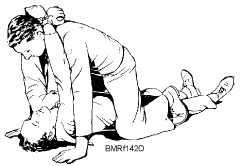1. Place the victim face down, as shown in figure
14-19, view A. Kneel on one knee at the head,
facing the victim. Pass your hands under the
armpits.
2. Raise the victim, as shown in figure 14-19, view
B. Take a better hold across the back.
3. Raise the victim to a standing position and stick
your right leg between the victim’s legs, as
shown in figure 14-19, view C. Grasp the
victim’s right wrist in your left hand and swing
the arm around the back of your neck and down
your left shoulder.
4. Stoop quickly and pull the victim across your
shoulders and, at the same time, put your right
arm between the victim’s legs, as shown in
figure 14-19, view D.
5. Grasp the victim’s right wrist with your right
hand and straighten up, as shown in figure
14-19, view E.
The procedure for lowering the victim to the deck is
shown in figure 14-19, views F and G.
TIED-HANDS CRAWL
The tied-hands crawl shown in figure 14-20 may be
used to drag an unconscious person for a short distance;
it is particularly useful when you must crawl underneath
a low structure.
RESCUE FROM ELECTRICAL CONTACT
Rescuing a person who has received an electric
shock is likely to be difficult and dangerous. Use
extreme caution or the rescuer may also be electrocuted.
Don’t touch the victim’s body, the wire, or any
other object that may be conducting electricity.
Some procedures you might use to rescue a person
who’s received an electric shock are as follows:
Look for the switch first of all, and if you find it,
turn off the current immediately. Don’t waste too
much time hunting for the switch; however,
every second is important.
If you cannot find the switch, you should try to
remove the wire from the victim with a dry
broom handle, branch, pole, oar, board, or
similar nonconducting object (fig. 14-21).
It may be possible to use dry rope or dry clothing
to pull the wire away from the victim.
You can also break the contact by cutting the wire
with a wooden-handled axe, but that is extremely
dangerous because the cut ends of the wire are
likely to curl and lash back at you before you
have time to get out of the way.
When you are trying to break an electrical
contact, always stand on some nonconducting
material, such as a dry board, newspaper, or
clothing.
Administer artificial ventilation immediately after
freeing the person from the wire if the electric shock
caused breathing to stop. Check the victim’s pulse,
since electric shock may also cause the heart to stop. If
14-26
Figure 14-20.—Tied-hands crawl.
Figure 14-21.—Pushing a victim away from a power line.
Student Notes:



